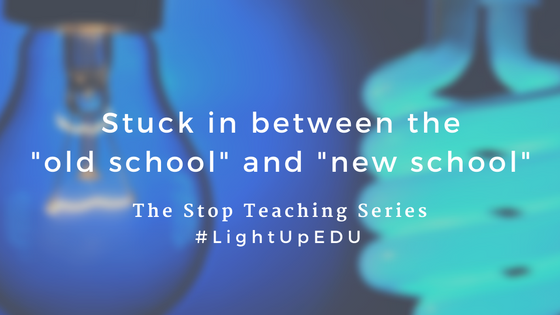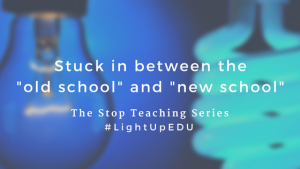Today, spontaneously, I had a powerful conversation with a colleague in the hallway. These are always the best conversations. We began talking about curriculum and these “new” assignments she wanted to implement. She talked about designing models, doing cost analyses, proposing ideas to administration and implementing these plans for the betterment of our school. She was excited. Her ideas were big. She talked about the impact these assignments would have on students. She was smiling.
This was genuine-the excitement about learning and inspiring that learning.
But, after about ten minutes of bouncing ideas off of one another and talking about the potential of this idea she had, she stopped. Defeated, she proclaimed, “well, that was fun but never will happen.” Why, I asked, even though I knew the answer. This time, though, I pushed her before she had time to turn around. She didn’t see it coming. And, she did something completely authentic.
She, like many educators, are stuck between two different worlds. Her thinking is ready to move into this “new world.” But, the majority of our stakeholders are not. She’s ready to jump. But, she doesn’t feel like she can because it’ll be so misunderstood. She’s standing at the edge. She wants to turn around and do what she’s always done. It’s safer. But, we know that it’s not the most effective.
I, again, come back to this question that continues to haunt me. Why do we continue to ignore the research about what works in our instruction and grading practices? We know what works. Marzano, Dweck, Hattie, DuFour, Guskey, Stiggins (and many more) have spent their careers researching and publishing about best practices. We dabble in these strategies but, ultimately, go back to our safe strategies. We haven’t truly embraced the research that should guide our practice.
We are living in one of the most exciting paradigm shifts in education. We are stuck between the old and the new. Teachers are struggling to wrap their brains around how to focus on being innovators who inspire learning when our stakeholders tend to focus on grades, tests and tasks. Many teachers are ready to be pushed. Their thinking is ready. They just don’t feel safe to jump.
Many teachers are ready to be pushed. Their thinking is ready. They just don’t feel safe to jump. Click To Tweet
As educational leaders, we’re teachers first. We need to cultivate a culture where teachers feel safe to risk. We should foster the excitement a teacher has about doing something different. And if it fails, reflect, improve and move on. But, what if it succeeds? It could radically change education.
It’s hard to change a system as large as the U.S. Education System. But, we have to try.
Team challenge: Stop teaching something old and jump into something new!
Team challenge: Stop teaching something old and jump into something new! Click To Tweet




Get new posts in your email!
Join our mailing list to receive the latest posts from LightUpEDU! We will never spam you, promise!
Please check your email to confirm your subscription!